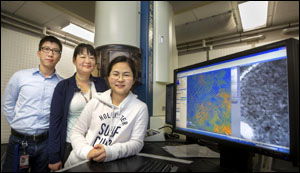Researchers Find Way To Stabilize Color Of Light In Next-Gen Material
11. 2. 2019 | Science Magazine | www.scienmag.com
A team of Florida State University physicists has found a way to stabilize the color of light being emitted from a promising class of next-generation materials that researchers believe could be the basis for efficient and more cost-effective optoelectronic technologies that can turn light into electricity or vice versa.
Physicists were working with a class of materials called halide perovskites. Researchers believe these materials have great potential for optoelectronic technologies because they are inexpensive to obtain and highly efficient. Researchers initially set out to make a higher-quality halide perovskite film that was smoother and more uniform than existing samples. They embedded nanocrystals in a special matrix in their sample. They were not prepared for this to affect the bandgap, or the physical property that determines the color of light being emitted or absorbed by the material.

This unique nanostructure turned the previously unstable materials into extremely stable ones even when they are stimulated by concentrated UV light 4,000 times more intensive than the solar radiation. The research is published in Nature Communications.
Read more at Science Magazine
Image Credit: FSU
-jk-




